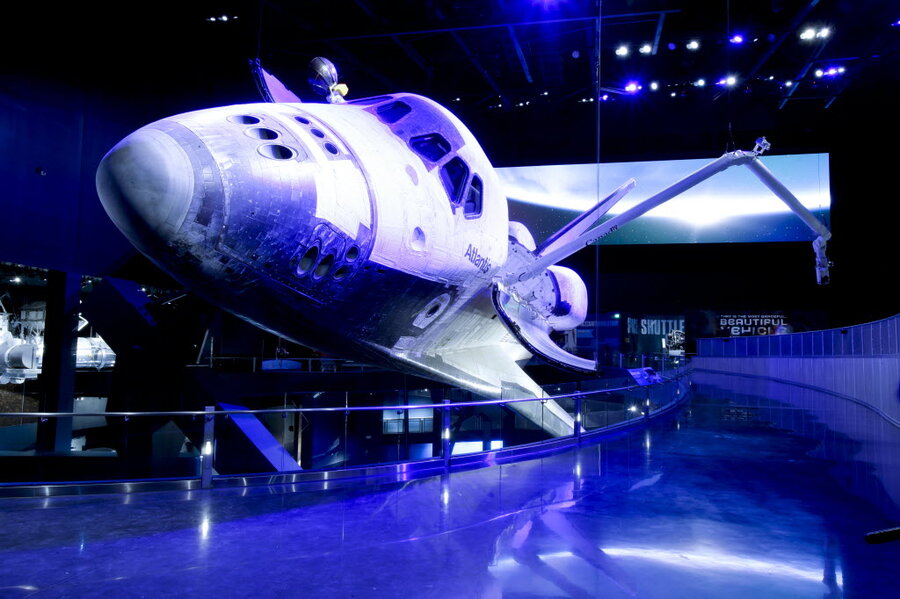A space shuttle's final mission: Atlantis opens to the public
Loading...
Space shuttle Atlantis will begin one last mission on Saturday – and this is one on which we can join her.
The Atlantis exhibit at the Kennedy Space Center, in Cape Canaveral, Florida, will open to the public on Saturday, after a Friday event that boasts some 50 astronauts on the guest list.
Some 60 displays and interactive simulators in the new, much-heralded exhibit will tell the story of the entire NASA shuttle program, which was closed in 2011. Those shuttles – beginning with the April 1981 launch of shuttle Columbia and continuing with the journeys of shuttles Challenger, Discovery, Atlantis and Endeavour – were the space ambassadors on which Americans pinned their celestial dreams for some three decades.
And so, in the center of it all, is the space shuttle Atlantis.
“Although the multimillion-dollar interactive exhibit encompasses much, much more than the display of Atlantis, there is no denying, she is truly the star of the show,” said Bill Moore, chief operating officer of the visitor complex. “We know that this majestic beauty, which safely ferried men and women to space and back on 33 successful missions, is the real reason that our guests will travel thousands of miles … to see her in all her glory."
Bathed in purple-blue light, the shuttle’s new 90,000-square-home looks part hanger, part space. Raised some 30 feet off the ground, the shuttle is tilted at a 43-degree angle, as it would be in flight. Its payload doors are open and its robotic arm is extended. Visitors can walk both under and around the shuttle on suspended bridges, like astronauts bobbing around their home.
“Atlantis is on display as she would be normally in flight. It’s the first time ever that a lot of people are going to see her this close,” Tim Macy, director of project development and construction for Delaware North Companies Parks and Resorts, told Florida Today.
The Atlantis exhibit cost about $100 million, culled together from borrowed Space Florida (the state's space infrastructure agency) funds and Kennedy Space Center Visitor Complex revenue, and was some 10 years in development. The complex is already home to a child-friendly "Angry Birds" interactive exhibit, a space shuttle simulator experience, and the US Astronaut Hall of Fame. [Editor's note: An earlier version misstated the cost of the exhibit.]
Atlantis was NASA’s fourth space shuttle, named after a boat that served as the primary research vessel for the Woods Hole Oceanographic Institute in Massachusetts from 1930 to 1966. It made its first flight in October 1983 and went on to make some seven missions to the Russian space station, Mir.
And some three decades later, it was the last NASA space shuttle to make a mission: Atlantis’ final flight from the International Space Station to Kennedy Space Center in July 2011 brought the shuttle program to its official close, turning expensive space shuttle flight over to private developers and heralding a beginning to NASA’s most ambitious goals, like sending an astronaut to an asteroid and then to Mars.
“Mission complete, Houston,” Capt. Christopher J. Ferguson of the Navy, commander of the Atlantis for the last flight, said just after the shuttle landed. “After serving the world for over 30 years, the space shuttle has earned its place in history, and it’s come to a final stop.”
Atlantis arrived at the museum last November, after traveling 10 miles from the Vehicle Assembly Building – an infinitesimal distance in space, but a difficult one for a shuttle to make on Earth – and was removed from 16,000-square-feet of plastic shrink-wrap last month.
“We say this is her next mission,” Macy told Florida Today. “Her mission is to tell the story.”
“We don’t know really what’s next in terms of manned space flight,” he said. “Nobody’s absolutely sure, but what we do know is that this shuttle and this shuttle program got us to where we are today.”








